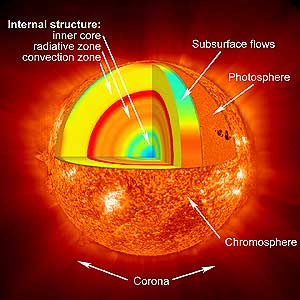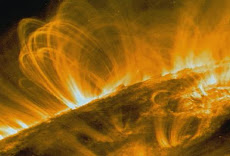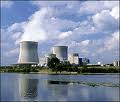
By Wele Gwir
What is radiation? Is it dangerous? Deadly? Desirable? Can we stop it? Do we need it? Can we avoid it?
This article will attempt to explain, in the simplest terms, what it is, where it comes from and how we use it to enhance the quality of life without destroying it.
In physics, radiation describes any process in which energy travels through a medium or through space, ultimately to be absorbed by another body. Non-physicists often associate the word ionizing radiation (e.g., as occurring in nuclear weapons, nuclear reactors, and radioactive substances), but it can also refer to electromagnetic radiation (i.e., radio waves, infrared light, visible light, ultraviolet light, and X-rays) which can also be ionizing radiation, to acoustic radiation, or to other more obscure processes. What makes it radiation is that the energy radiates (i.e., it travels outward in straight lines in all directions) from the source. This geometry naturally leads to a system of measurements nd physical units that are equally applicable to all types of radiation.
Ionizing radiation
Some types of radiation have enough energy to ionize particles. Generally, this involves an electron being 'knocked out' of an atom's electron shells, which will give it a (positive) charge. This is often disruptive in biological systems, and can cause mutations and cancer.
These types of radiation generally occur in radioactive decay and waste.
The three main types of radiation were discovered by Ernest Rutherford, The Alpha, Beta, and Gamma rays. They were found through simple experimentation, Rutherford used a radioactive source and found out that the rays produce hit three different areas. One of them being the positive, one of them being neutral, and one of them being negative. He figured out the charges by the place they hit. Using this data, Rutherford concluded that radiation consisted of three rays. He named them after the first three letters of the Greek alphabet alpha, beta, and gamma.
Alpha radiation
Alpha (α) decay is a method of decay in large nuclei. An alpha particle (helium nucleus, He2+), consisting of 2 neutrons and 2 protons, is emitted. Because of the particle's relatively high charge, it is heavily ionizing and will cause severe damage if ingested. However, due to the high mass of the particle, it has little energy and a low range; typically, alpha particles can be stopped with a sheet of paper (or skin).
Beta(+/-) radiation
Beta-minus (β-) radiation consists of an energetic electron. It is less ionizing than alpha radiation, but more than gamma. The electrons can often be stopped with a few centimeters of metal. It occurs when a neutron decays into a proton in a nucleus, releasing the beta particle and an antineutrino.
Beta-plus (β+) radiation is the emission of positrons. Because these are antimatter particles, they annihilate any matter nearby, releasing gamma photons.
Gamma radiation
Gamma (γ) radiation consists of photons with a frequency of greater than 1019 Hz[1]. Gamma radiation occurs to rid the decaying nucleus of excess energy after it has emitted either alpha or beta radiation. Both alpha and beta particles have an electric charge and mass, and thus are quite likely to interact with other atoms in their path. Gamma radiation is comprised of photons, and photons have neither mass nor electric charge. Gamma radiation penetrates much further through matter than either alpha or beta radiation.
Non-ionizing radiation
Non-ionizing (or non-ionising) radiation, by contrast, refers to any type of radiation that does not carry enough energy per photon to ionize atoms or molecules. It especially refers to the lower energy forms of electromagnetic radiation (i.e., radio waves, microwaves, terahertz radiation, infrared light, and visible light). The effects of these forms of radiation on living tissue have only recently been studied. Instead of producing charged ions when passing through matter, the electromagnetic radiation has sufficient energy to change only the rotational, vibrational or electronic valence configurations of molecules and atoms. Nevertheless, different biological effects are observed for different types of non-ionizing radiation.[1][2]
Neutron radiation
Neutron radiation is a kind of non-ionizing radiation that consists of free neutrons. These neutrons may be emitted during either spontaneous or induced nuclear fission, nuclear fusion processes, or from other nuclear reactions. It does not ionize atoms in the same way that charged particles such as protons and electrons do (exciting an electron), because neutrons have no charge. However, neutrons readily react with the atomic nuclei of many elements, creating unstable isotopes and therefore inducing radioactivity in a previously non-radioactive material. This process is known as neutron activation.
Electromagnetic radiation
Electromagnetic radiation (sometimes abbreviated EMR) takes the form of self-propagating waves in a vacuum or in matter. EM radiation has an electric and magnetic field component which oscillate in phase perpendicular to each other and to the direction of energy propagation. Electromagnetic radiation is classified into types according to the frequency of the wave, these types include (in order of increasing frequency): radio waves, microwaves, terahertz radiation, infrared radiation, visible light, ultraviolet radiation, X-rays and gamma rays. Of these, radio waves have the longest wavelengths and Gamma rays have the shortest. A small window of frequencies, called visible spectrum or light, is sensed by the eye of various organisms, with variations of the limits of this narrow spectrum. EM radiation carries energy and momentum, which may be imparted when it interacts with matter.
The electromagnetic spectrum
The electromagnetic spectrum is the range of all possible electromagnetic radiation frequencies.[1] The electromagnetic spectrum (usually just spectrum) of an object is the characteristic distribution of electromagnetic radiation emitted by, or absorbed by, that particular object.
Light
Main article: Light
Light, or visible light, is electromagnetic radiation of a wavelength that is visible to the human eye (about 400–700 nm), or up to 380–750 nm.[1] More broadly, physicists refer to light as electromagnetic radiation of all wavelengths, whether visible or not.
Thermal radiation
Thermal radiation is the process by which the surface of an object radiates its thermal energy in the form of electromagnetic waves. Infrared radiation from a common household radiator or electric heater is an example of thermal radiation, as is the heat and light (IR and visible EM waves) emitted by a glowing incandescent light bulb. Thermal radiation is generated when heat from the movement of charged particles within atoms is converted to electromagnetic radiation. The emitted wave frequency of the thermal radiation is a probability distribution depending only on temperature, and for a genuine black body is given by Planck’s law of radiation. Wien's law gives the most likely frequency of the emitted radiation, and the Stefan–Boltzmann law gives the heat intensity.
Black-body radiation
Black-body radiation is a common synonym for thermal radiation (see above). It is so-called because the ideal radiator of thermal energy would also be an ideal absorber of thermal energy: It would not reflect any light, and thus would appear, at cooler temperatures, to be absolutely black. (Wikipedia on line)
Radiation has many uses in the fields of medicine and science. These modern advances in the application of various forms of radiation, have enable us to destroy cancer cells, date our history and enhance our communications.
Radiation and radioactive substances are used for diagnosis, treatment, and research. X rays, for example, pass through muscles and other soft tissue but are stopped by dense materials. This property of X rays enables doctors to find broken bones and to locate cancers that might be growing in the body. Doctors also find certain diseases by injecting radioactive substance and monitoring the radiation given off as the substance moves through the body.
In Communication
All modern communication systems use forms of electromagnetic radiation. Variations in the intensity of the radiation represent changes in the sound, pictures, or other information being transmitted. For example, a human voice can be sent as a radio wave or microwave by making the wave vary to correspond variations in the voice.
In Science
Researchers use radioactive atoms to determine the age of materials that were once part of a living organism. The age of such materials can be estimated by measuring the amount of radioactive carbon they contain in a process called radiocarbon dating. Environmental scientists use radioactive atoms known as tracer atoms to identify the pathways taken by pollutants through the environment.
Radiation is used to determine the composition of materials in a process called neutron activation analysis. In this process, scientists bombard a sample of a substance with particles called neutrons. Some of the atoms in the sample absorb neutrons and become radioactive. The scientists can identify the elements in the sample by studying the radiation given off.(Wikipedia)
In our next article we will discuss the most common form of radiation we are all familiar with: Our Sun.









